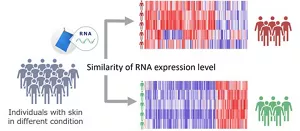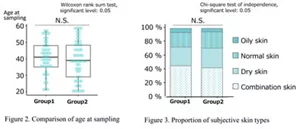Sebum RNA Monitoring Technology
Skin Type Classification Using Sebum RNA Developed
Two Skin Types with Different Gene Expression (RNA) Characteristics Discovered
The Biological Research Division of Kao Corporation has announced the discovery of at least two skin types with different expression levels of RNA, which is essential for skin functions, classified according to similarity of expression information in the RNA contained in sebum (sebum RNA*1 ). It also determined that these skin types are independent classifications unrelated to age or subjective skin type (dry skin, oily skin, etc.).
Kao intends to widely utilize this skin classification as a new index for objectively understanding the skin and helping consumers select optimal cosmetic products and skincare.

Classification of skin types based on gene expression characteristics (RNA expression level) (graphic representation)
The Biological Research Division’s findings were presented at the 1st Annual Congress of the Society of Cosmetic Chemists of Japan, held December 5–7, 2023 in Saitama prefecture and received the award for best oral presentation.
-
* 1 Kao News Release dated June 10, 2019: Kao’s original non-invasive analytical method for monitoring RNA - Discovery of the presence of human RNA in sebum
Background
Kao discovered the presence of human RNA in sebum in 2019 and developed sebum RNA monitoring technology, a non-invasive method for global analysis of RNA extracted from facial sebum collected with oil blotting film. Whereas DNA is information particular to an individual that remains the same throughout the person’s lifetime, RNA varies from day to day depending on environmental factors like physical condition, diet, exercise, stress or UV rays, which makes it useful for learning about the skin’s condition at a particular time.
In spring 2022, Kao began working with istyle Inc. on a study grouping individuals with similar sebum RNA expression information to explore their tendencies in preferences for cosmetics*2 . The aim of the collaboration is to use RNA-based skin type as an objective index allowing consumers to efficiently select cosmetics matching their own skin type and optimize skin care.
This research developed skin classifications according to the characteristics of gene expression in sebum RNA and examined some of the characteristics of those skin types.
Development of skin type classifications based on similarity of sebum RNA expression information
In January and February 2019, researchers conducted a hierarchical clustering analysis*3 based on the RNA expression information of approximately 2,300 genes from sebum RNA collected from 105 women between the ages of 20 and 59. Research results confirmed the existence of two clusters, based on similarity of RNA expression (Figure 1).
-
* 3 A grouping technique in which data elements are grouped in order of most similarity and the process is repeated until all the observed values are combined into a large group. The grouping process can be rendered graphically as a hierarchy.

Analyzing features of the two skin types with different gene expression characteristics
To identify the characteristics of gene functions in each group, gene set enrichment analysis*4 was performed, focusing on the 662 genes for which there were clear differences between the groups in terms of RNA expression level. Results of the analysis showed that in Group 1, genes related to immune response work for skin immune functions were expressed strongly, while in Group 2, genes related to keratinization functions of the skin barrier were expressed strongly. There were no age deviations between the two groups (Figure 2), and neither was there any correlation with participants’ self-reported skin types (oily, dry, combination or normal skin), suggesting that these skin types are independent indexes (Figure 3). Research also confirmed that the same individual might belong to a different group, depending on when the sebum RNA sample was taken.
-
* 4 Method for analyzing the characteristics of gene clusters to determine how much genes for specific functions are enriched, among the many genes focused on.

Summary
Following analysis of clustering based on similarity of sebum RNA expression information, the study discovered that there are at least two skin types having characteristic expression of important genes with either immune response or keratinization functions. Kao believes that this classification utilizing sebum RNA monitoring technology has the potential to be used as a skin classification index to objectively understand the skin based on biomolecular information.
Kao will continue deepening its knowledge in this aspect of classification and will aim to create new experiential value, especially in the field of cosmetics and beauty care, by making wide use of skin type classifications based on sebum RNA expression information.
About Kao
Kao creates high-value-added products and services that provide care and enrichment for the life of all people and the planet. Through its portfolio of over 20 leading brands such as Attack, Bioré, Goldwell, Jergens, John Frieda, Kanebo, Laurier, Merries, and Molton Brown, Kao is part of the everyday lives of people in Asia, Oceania, North America, and Europe. Combined with its chemical business, which contributes to a wide range of industries, Kao generates about 1,530 billion yen in annual sales. Kao employs about 34,300 people worldwide and has 137 years of history in innovation. Please visit the Kao Group website for updated information.
Media inquiries should be directed to:
Public Relations
Kao Corporation
